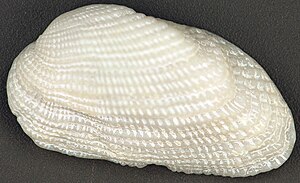Acar (genus)
| Acar | ||||||||||||
|---|---|---|---|---|---|---|---|---|---|---|---|---|

|
||||||||||||
| Systematics | ||||||||||||
|
||||||||||||
| Scientific name | ||||||||||||
| Acar | ||||||||||||
| Gray , 1857 |
Acar is a shell - genus from the family of ark shells (Arcidae).
features
The z. The housings, some of which are somewhat irregular, are small to medium-sized and have an oblong-trapezoidal shape or roughly rectangular shape. The forward curved vertebra sits in the front part of the housing, i. H. the rear part of the case is significantly longer. The dorsal margin is straight but short in relation to its overall length. In the rear part of the housing there can be a keel running from the vertebra to the transition from the rear edge to the ventral edge. The rear end (transition rear edge / ventral edge) can be pointed or very tightly rounded. The gaping opening for the linen is narrow, if at all. The ventral margin is almost straight or slightly s-shaped.
The slightly curved edge of the lock has a continuous row of vertical or inclined, z. T. angled teeth on; the teeth become larger towards the outside and are more tilted. The external ligament is opisthodal, i. H. it's behind the vertebrae.
The shell is comparatively thick and the housing is comparatively heavy. The periostracum is very thin and decrepit. The ornamentation consists of fine but rough radial ribs and fine concentric ribs, which can also be drawn out somewhat like roof tiles. The points of intersection of the radial and concentric ribs are often serrated.
The two elongated egg-shaped sphincters are unequal in size, the front one is significantly smaller than the rear sphincter. The attachment points of the sphincter muscles are often calcified, i. H. at this point a special layer of shell forms (myostracum).
Similar genera
The shells of the Barbatia species are usually somewhat smaller and rather oblong-egg-shaped. They are mostly flat, i.e. H. not particularly bloated. The dorsal margin does not extend over the entire length of the housing. On the rear part of the case, a keel from the vertebra to the rear edge is missing or only a weak keel is formed. The genus Arca , on the other hand, always has very pronounced keels and a very long dorsal edge that extends over almost the entire length of the housing.
Geographical distribution and habitat
The genus is common in the Atlantic and Pacific. It occurs there from shallow water to a depth of about 2000 meters. It lives in crevices and crevices, under stones and in hollows; due to the cramped conditions in these habitats, the housings are occasionally shaped somewhat irregularly.
Taxonomy
The taxon was established in 1857 by John Edward Gray as a subgenus of Barbatia . Gray named three species as belonging to the new (sub) genus: Barbatia reticulata , Barbatia divaricata and Barbatia gradata . The type species is Arca gradata Broderip & GB Sowerby I, 1829. The MolluscaBase and the Paleobiology Database add the following species to the genus Acar :
- Acar abdita Oliver & Chesney, 1994
- Acar agulhasensis (Thiele & Jaeckel, 1931)
- † Acar aspera Conrad, 1854 ( Eocene )
- Acar bailyi Bartsch, 1931
- Acar botanica (Hedley, 1917)
- Acar carditaeformis (Dautzenberg & Fischer, 1897)
- † Acar celleporacea (Tate, 1886) ( Miocene )
- † Acar cheribonensis Oostingh, 1935 ( Pliocene )
- Acar clathrata (Defrance, 1816)
- Acar congenita (EA Smith, 1885)
- Acar decorata (Hayami & Kase, 1993)
- Acar domingensis (Lamarck, 1819)
- Acar dubia (Baird, 1873)
- Acar gradata (Broderip & GB Sowerby I, 1829)
- † Acar harringtoni Laws, 1947 (Miocene / Pliocene)
- † Acar lamellosa (Deshayes, 1858) (Eocene)
- Acar lepidoformis Francisco, Barros & Lima, 2012
- † Acar lyelli (Tate, 1886) ( Miocene )
- Acar marsupialis Oliver & Holmes, 2004
- Acar naturezae Francisco, Barros & Lima, 2012
- Acar oliveirae Francisco, Barros & Lima, 2012
- Acar olivercoseli M. Huber, 2010
- † Acar opuraensis (Powell & Bartrum, 1928)
- Acar petasion (Kilburn, 1983)
- Acar plicata (Dillwyn, 1817)
- † Acar powelli Laws, 1950
- Acar pusilla (GB Sowerby I, 1833)
- Acar requiescens (Melvill & Standen, 1907)
- Acar rostae (Berry, 1954)
- Acar sandersonae Powell, 1933
- Acar sociella (Brookes, 1926)
- Acar squamosa (Lamarck, 1819)
- Acar transmar Simone, 2009
- † Acar trapeziformis (Martin, 1879) (Miocene)
- † Acar whangaensis (Marwick, 1928)
Some species were discussed by Huber in 2010.
supporting documents
literature
- Rudolf Kilias: Lexicon marine mussels and snails. 2nd edition, 340 p., Verlag Eugen Ulmer, Stuttgart 1997 ISBN 3-8001-7332-8 (p. 25)
- Raymond Cecil Moore (Ed.): Treatise on invertebrate paleontology. Mollusca, 6, Bivalvia 1. XXXVIII, 489 pp., New York, 1969 (pp. N250 / N252).
- Fritz Nordsieck: The European sea shells (Bivalvia). From the Arctic Ocean to Cape Verde, the Mediterranean Sea and the Black Sea. 256 p., Gustav Fischer Verlag, Stuttgart 1969 (p. 19)
Individual evidence
- ^ John Edward Gray: A Revision of the Genera of some of the Families of Conchifera or Bivalve Shells. Part III. Arcadae. Annals and Magazine of Natural History 19: 366-373, 1857 Online at www.biodiversitylibrary.org (p. 369)
- ^ MolluscaBase: Acar Gray, 1857
- ^ Paleobiology Database: Acar Gray 1857
- ↑ a b Maxime Glibert, Luc van de Poel: Les Bivalves fossiles du Cénozoïque Étranger des collections de l'Institut Royal des Sciences Naturelles de Belgique. I. Palaeotaxodonta et Eutaxodonta. Institut Royal des Sciences Naturelles de Belgique / Koninklijk Belgisch Instituut voor Natuurwetenschappen, Mémoires / Verhandelingen, 2nd Série / Reeks, 77: Brussels 1965 PDF (73 MB!)
- ^ Markus Huber: Compendium of Bivalves. 901 S., Hackenheim, ConchBooks, 2010 ISBN 978-3-939767-28-2

